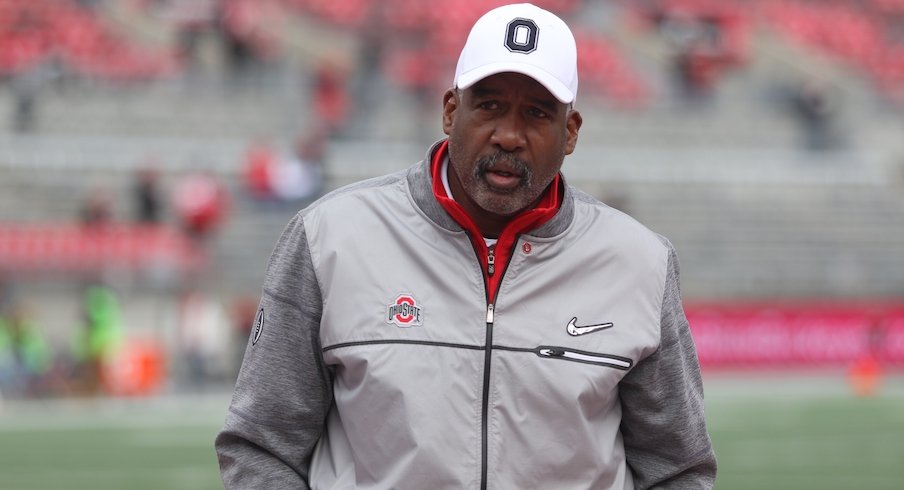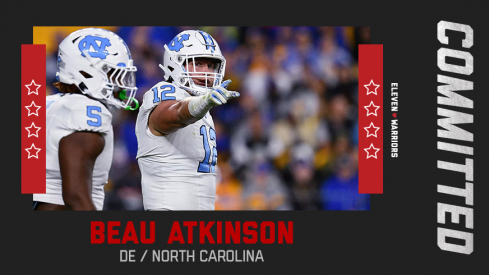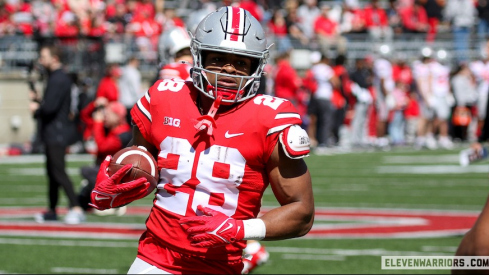While many people involved in college athletics have started to speculate on whether or not there will be a football season this fall, Ohio State athletics director Gene Smith isn’t ready to go down that road yet.
In an interview with News Radio 610 WTVN on Friday morning, Smith said “it’s still too early to truly speculate what the fall will bring to us” in regard to whether the college football season will proceed as scheduled.
“We’ve been busy, frankly, trying to adjust to our new normal,” Smith said Friday in his first public comments since March 13, the day after the NCAA Tournament was canceled due to the coronavirus pandemic.
Before a college football season can be played, teams need to have enough time to be able to train in preparation for the start of the season, so Smith said the conversation right now is primarily focused on determining when and how players can get back on the practice field.
“We really have to understand that the players did not have their spring football, so that’s physical activities lost, and remember, typically in the summertime, there is training that occurs,” Smith said. “So at the end of the day, we need to develop a return-to-play model for those players that’s frankly practice-oriented, so that we avoid soft-tissue injuries that occur in muscles and tendons and ligaments and end up with sprains and strains and contusions.
“All of us are collaborating to determine what’s the best return to play for the players, and then ultimately the conversation will shift to what the season will be.”
Ohio State coach Ryan Day, in an interview on ESPN’s “Get Up” on Friday morning, said he believes college football teams will need “about six weeks” to practice before the start of the season, but that there will be ongoing conversations between coaches and college athletics leaders over the next few months to figure out how to best work through the situation.
“Whether it’s more or less, I think that’s what we have to work through,” Day said. “What do those six weeks look like? When are we allowed to put pads on? How much time do we need leading up to putting pads on and actually practicing? So I think six weeks is a good starting point to start the conversation and then as time goes on, we need to clean that up.”
”We need to develop a return-to-play model for those players that’s frankly practice-oriented, so that we avoid soft-tissue injuries that occur in muscles and tendons and ligaments and end up with sprains and strains and contusions.”– Gene Smith on the importance of practice time before the college football season
Ohio State president Michael Drake said Thursday, in an interview with WOSU, that he could potentially see football games being played this season without fans in the stands or with reduced attendance. Day said Friday he believes “we need to look at everything, because I think any football is better than no football.” Smith, however, said he’s uncertain whether it will be possible to create an environment that’s truly safe for players if it isn’t safe for fans.
“It seems inconsistent to me that we could say it’s unsafe for the fans to be in the stands but it’s safe for the players, to be in that gathering environment,” Smith said. “I don’t know. I haven’t gone down that path, but I think you guys know me, I tend to lean to work with my colleagues in the Big Ten and work with my colleagues nationally. My focus, first and foremost right now, is if we’re going to do something, how do we make sure the players are safe first?”
Smith acknowledged that some decisions will be out of the NCAA’s hands, as college athletics will be forced to abide by any state and federal orders that remain in place restricting large gatherings. Given that Ohio State’s sports teams participate in competitions all over the country – for instance, the football team is scheduled to play at Oregon in its second game of the 2020 season – Smith said it is necessary for everyone to be on the same page nationally.
“There’s a lot of discussions that have to occur. A lot of things that have to synchronize. We have to have consistency across the country,” Smith said. “We have to be sensitive to all the environments across the country.”
Smith didn’t rule out the possibility that Ohio State could take measures like taking student-athletes’ temperatures once team activities resume, but he said he expects new public health measures to be taken all over the country and not just in athletics.
“President Drake and I were talking about this, you hearken back to 9/11, and you had an unfortunate circumstance, but then you think after that, all of us who were going to the airport, we had a lot of interesting comments about our challenge at security and the TSA operations and now, it’s normal,” Smith said. “And so now, will you take your temperature before you leave the house? Will we have temperature devices at certain places? I don’t know that. But yeah, I think there’s gonna be some new normals for us as a result of this. I never knew that 20 seconds washing your hands was so long. I don’t know if I’ve ever truly washed my hands for 20 seconds. So our hygiene habits are gonna change, and our monitoring habits are going to change.”
Smith said Ohio State will prepare for the “worst-case scenarios” in regards to the possibility that football and other sports could be impacted in the 2020-21 academic year, but for now, Ohio State is projecting its athletic department budget for next year based on normal operations. And even with the cancellation of the NCAA Tournament, the spring game and all spring sports, Smith said the athletic department’s finances for the 2020 fiscal year were not severely impacted.
“We feel good about where we’re gonna end up,” Smith said. “Keep in mind a lot of our revenue was in and frankly, as sad as it was and as unfortunate as it was, there’s a lot of expenditures that weren’t incurred as a result of stoppage of activity. The spring sport operational costs, things of that nature, travel. We’ve implemented a freeze on hires. So this fiscal year, we’ll be fine.”


